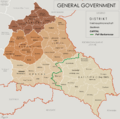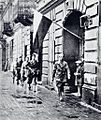General Government facts for kids
The General Government (also called GG) was a special area in central Poland during World War II. After Nazi Germany took over parts of Poland in 1939, this region was set up as a separate area. It had its own German leaders and military control. It was not a fully independent country, but it was also not a puppet state like some other occupied lands. The people in charge were Germans who strongly supported the Nazi party.
How the General Government Was Created
Germany invaded Poland on September 1, 1939. This event marked the start of World War II. Germany quickly defeated Poland in just 18 days. On September 18, the Soviet Union also invaded Poland. This happened because of a secret agreement between Germany and the Soviet Union called the Ribbentrop-Molotov Pact.
Because of these invasions, Poland was divided into three main parts:
- The western part was directly added to Nazi Germany. This area was called Wartheland.
- The eastern part was taken by the Soviet Union. Much of this land stayed with the Soviet Union even after the war.
- The central part remained under German control. On October 12, 1939, Adolf Hitler issued a special order. This order officially created the General Government in this central area.
At first, the General Government included four important Polish regions: Warsaw, Radom, Lublin, and Kraków. In August 1941, the General Government grew even larger. It took in the region of Galicia, which had been taken from the Soviet Union. The city of Kraków became the capital of the General Government.
Images for kids
-
Hans Frank, the main leader of the General Government, at a police parade in Kraków during the German occupation of Poland
-
The border between Germany and the Soviet Union after their invasion of Poland. This border was agreed upon in Moscow by Joseph Stalin and Joachim von Ribbentrop in September 1939.
-
Hans Frank with district administrators in 1942. From left: Ernst Kundt, Ludwig Fischer, Hans Frank, Otto Wächter, Ernst Zörner, Richard Wendler.
-
A German announcement from November 25, 1941, about the execution of nine Polish farmers. They were executed for not providing their required quotas of goods. This was signed by the governor of the Lublin district.
-
An announcement from September 5, 1942, by the Chief of the SS and Police. It stated that Poles helping Jewish people would face the death penalty.
-
During the Warsaw Ghetto Uprising in April 1943, Jewish people are held at gunpoint by SS troops. This image is from a report written by Jürgen Stroop.
-
Polish soldiers in action during the Warsaw Uprising on August 1, 1944.
-
The painting Portrait of a Young Man by Raphael. It was stolen by Hans Frank's orders in 1939 and was never returned. This was one of over 40,000 artworks taken from Polish collections.
-
Another image from the Warsaw Uprising in 1944.
See also
 In Spanish: Gobierno General para niños
In Spanish: Gobierno General para niños























